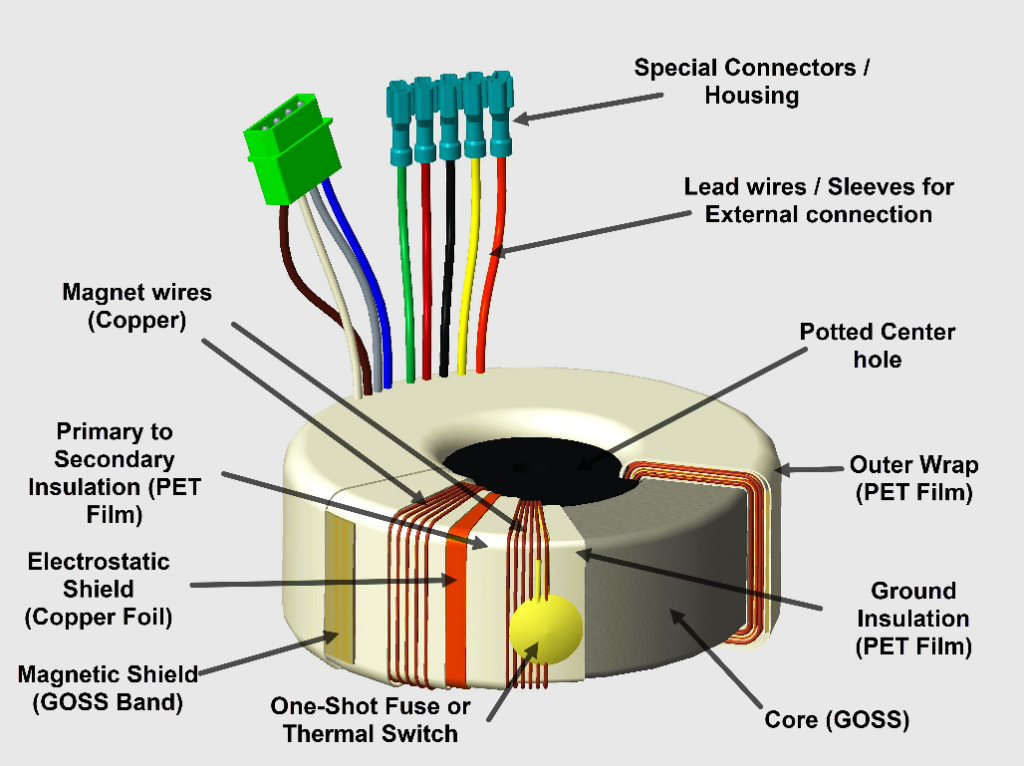
Core Material Selection
In general, the price of a transformer is determined by its core and copper, with all other materials contributing only 10~15% to the price. Pricing for copper is generally determined by the London Metal Exchange (LME), but the cost of the core can vary widely based on material selection
Some low-cost manufacturers (many based in China) are able to reduce prices by using recycled steel (Grade B) for their transformer cores. However, this cheaper core material comes at the cost of lower reliability and performance.
High-performance cores are manufactured from a continuous strip of premium-grade virgin steel, leaving no air gaps and loose sheets of steel or laminations to cause vibration. The use of virgin material also allows engineers to design transformers at a magnetic induction point specified by the mills, thus reducing losses associated with the transformers.
Low noise and high efficiency are two popular reasons for choosing toroidal transformers. Talema has developed specialized manufacturing techniques to provide the quietest cores possible without any of the common downsides, such as higher losses, and larger dimensions.
Magnet Wire Selection
Wire for winding used in electrical equipment is generally called magnet wire. Aluminum and copper are both used for this purpose, but copper is generally preferred in toroidal transformers due to its current carrying capacity, cost, size, and electrical and thermal properties.
The windings on a toroidal transformer are exposed over the entire surface of the transformer — affording optimum transfer of waste heat from the copper windings. This often will allow the designer to use somewhat smaller gauge wire than would otherwise be prudent — without exceeding the specified temperature rise limit — if load regulation and efficiency considerations allow.
Dual-coated enameled wire is also important for mitigating the risk of short circuit after the wire has been wound around the core.
Winding Techniques
The winding process of the toroidal transformer is also particularly important. Winding construction can greatly influence leakage inductance, so special care must be taken for specific leakage current applications.
The winding of the enameled wire must be evenly arranged and leveled, and the winding strength of the machine must be properly adjusted to avoid perforation of the enameled wire in the winding process. Thus the enameled wire can evenly surround the toroidal core without the risk of a short circuit.
Bank winding Technique
A bank winding is one in which the coil is wound such that portions of a total winding are wound in a number of pie-shaped segments around the toroid. After the desired odd number of segments have been wound in one direction (clockwise), the subsequent even number of segments are wound in the other direction (counterclockwise). This is repeated until the winding is complete. Bank winding greatly reduces the maximum turn-to-turn voltage gradient or stress on the conductor insulation. Thus providing protection against voltage spikes which are very common in any application.
Interwinding Insulation Technique
The interwinding insulation technique places a layer of mylar insulation at the halfway point of a single primary winding or between individual windings in a dual primary configuration.
Choosing appropriate Insulation Materials
The insulation material of the toroidal transformer determines its safety and service life. The better the insulation material, the stronger the impact resistance. Proper insulation greatly reduces the possibility of short-circuiting and leakage, which allows for a very long working life of the transformer.
Generally, all transformers must meet international safety standards, such as those issued by Underwriters Laboratories (UL) and the International Electrotechnical Commission (IEC). These safety codes specify insulation data for dry-type plastic-based insulation used between primary and secondary windings in toroidal power transformers, such as the minimum total thickness of the insulation (DTI), minimum number of layers of plastic film, and minimum creepage distance along the surface of insulation material.
Toroidal transformers require insulation in different places or stages of construction. International safety standards specify minimum requirements for total insulation thickness, as well as the number of layers of insulation and creepage required. Insulation is provided between the toroidal core and the first winding (ground insulation), between successive windings (Inter-winding insulation), and on the outside of the last winding (outer wrap).
The core insulation is usually made in one of the following ways:
- Curing an insulating layer of plastic or ceramic material on the outer surface of the core.
- Fitting plastic caps on the top and bottom of the core.
- Winding a narrow strip of plastic material in overlapping fashion through the center hole in the toroid.
The first two core insulation methods are not Suitable for insulation arranged on a winding, because a winding cannot withstand the high curing temperature, and the size and shapes of windings are so variable that standardized caps cannot be used. Insulation on windings is thus made almost exclusively by winding a narrow strip of plastic material through the center of the toroid in an overlapping fashion.
Impregnation
Transformers with low power ratings and small wire sizes can be impregnated to have a longer life and to avoid any short circuit. In special applications such as audio, the toroidal core is often impregnated to arrest audible hum.
Lead Wires and Sleeves
As with insulation, lead wires and sleeves must meet international safety standards. Talema typically uses lead wires of UL category AVLV2 with a minimum of 300 V cables, and sleeves of UL category YDPU2/UZFT2 with a minimum of 300V tubes. Both of these are selected as per EN61558, UL5085, UL60601-1, and UL62368 standards. Lead wires and sleeving material of higher voltage/temperature categories are used on transformers of higher insulation classes (class B and F).
Electrostatic Shield
Electrostatic screens are sometimes added to toroidal transformers to filter out electrostatic interference from the mains power supply and to derive to ground in case of failure of the main isolation. The screens are constructed using a copper layer winding coil, insulated with polyester, which usually winds between the primary and secondary windings. There are two construction techniques available: outside closed and outside open.
Magnetic Shield
Toroidal transformers already have low magnetic leakage fields by nature. If a further reduction is required, then the transformers can be supplied with additional magnetic shielding. This shielding uses a thin sheet of grain-oriented silicon steel with multiple layers tightly wound around the toroidal transformer circumference and fixed with an outer wrap.
Potting or Encapsulation
Thermoplastic material is used for potting or encapsulation and provides excellent protection against shock and vibration. The potting material can also be thermally conductive if desired.
Conclusion
The overall quality of a toroidal transformer is determined by many design choices. As with any engineered component, cost is a function of the quality of materials and construction techniques. The design engineers at Talema have decades of combined experience designing custom magnetics and would be happy to help you specify components for your next project. Contact us today!





